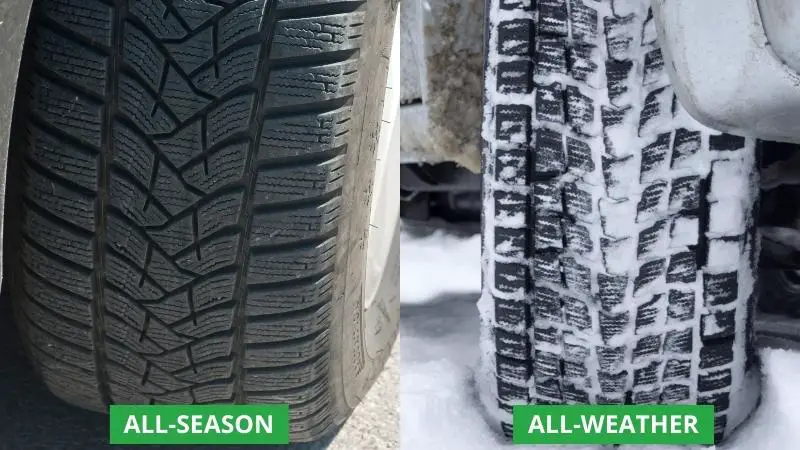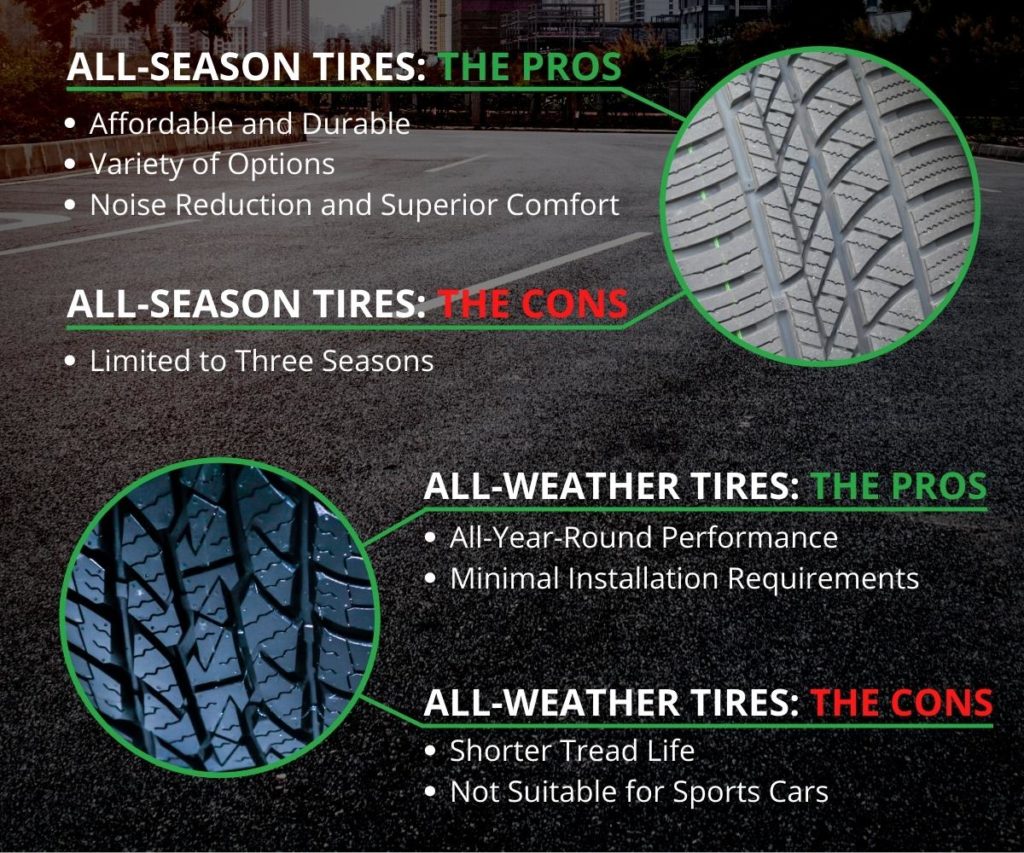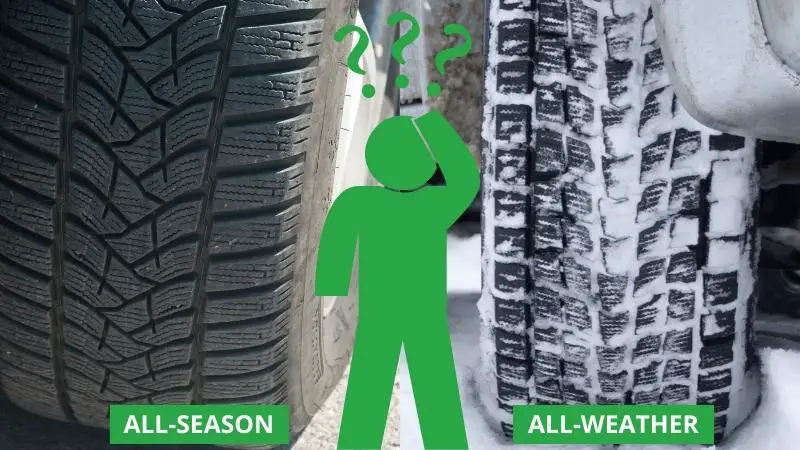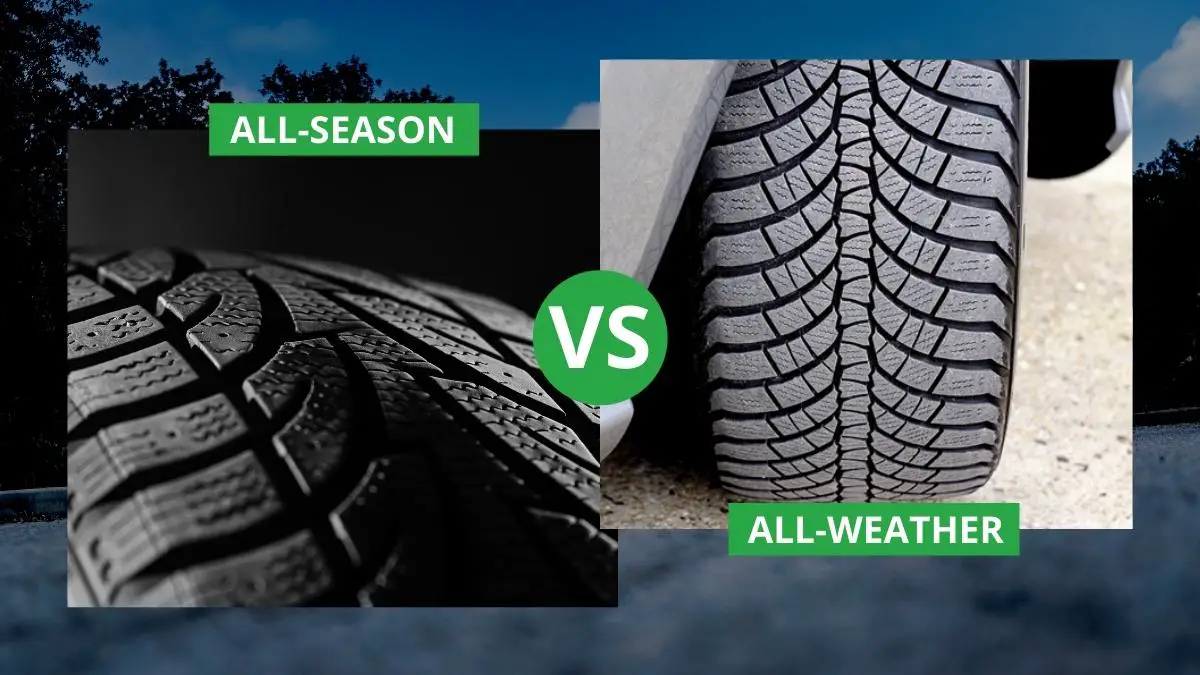You may have found it confusing when you hear all-season and all-weather tires compared against each other.
Conventional wisdom will dictate that both all-weather and all-season mean the same thing, right?
Well, not exactly.
So, what’s the difference between all-weather tires and all-season tires?
All-season tires offer optimal performance during summer, spring, and fall, but are not optimized for winter conditions when temperatures drop below 7 degrees Celsius (46 degrees Fahrenheit). All-weather tires, on the other hand, have many of the same features of an all-season tire, while also being suitable for winter driving conditions.
In this article, we will look at the differences between both tires, the pros and cons of each type of tire, and what you should consider when picking the right tire for you.
What’s the Difference Between All-Season And All-Weather Tires?
There are key differences between all-weather and all-season tires that enable all-weather tires to provide you with year-round traction. These differences include:
Different Tread Compounds
All-season tires work best in warmer conditions, and if you push them a little hard on wet pavement or over snow, you will start to lose traction.
Although some premium all-season tires will perform adequately in weather conditions below 7-degree Celsius (46-degree Fahrenheit), their performance will still be vastly inferior to that of winter tires and all-weather tires.
This is because all-season tires are built with harder rubber and tread compounds that function best at high temperatures but become pliable at lower temperatures. This ensures longer tread life and optimal performance in moderate climates but becomes a weakness in freezing temperatures.
All-weather tires on the other hand, are built with softer rubber and special compounds that ensure the tire performs like an all-season tire in warmer conditions, but still stays flexible in colder temperatures.
This gives you a tire that works well outside winter months but will also help you avoid swapping out your tires for a coming snowstorm.
Distinct Tread Patterns

The basic rule of tire tread design is that the more the surface area, the better the traction and grip of the tire. This is why high-performance tires that are designed for dry roads have a wide surface area and minimal to zero tread pattern since that will give them maximum contact with the road.
However, this wide surface area becomes a liability in wet conditions because you will have more contact with the road and water, which reduces traction. Summer tires deal with this issue by having tread grooves that channel the water and ensure you stay glued to the road.
Winter tires take this a step further and use more tread patterns and grooves with biting edges to ensure you retain traction in the harshest of conditions.
But, what about the tread patterns of all-season and all-weather tires?
All-season tires have grooves that are deeper and wider than those of summer tires to ensure the tire grips the road better in warm conditions and repels water better when you are driving in the rain. They also have small sipes that provide some degree of traction in snowy conditions.
These combinations of features are adequate for a wide range of driving conditions, but it’s still insufficient for safe winter driving. Read the post “Can You Use All-Season Tires During Winter?” to learn more about using all-season tires during winter conditions.
All-weather tires feature an even more aggressive tread design and siping that performs well in warmer conditions while offering impressive winter slip resistance. All-weather tires also carry the 3-Peak mountain snowflake symbol that qualifies them as winter traction tires.
All-Season vs All-Weather Tires: Pros and Cons
To pick the right tire for your needs, you need to fully understand the advantages and disadvantages of each type of tire. We will examine those below:

All-Season Tires: The Pros
1. Affordability and Durability
All-season tires are available across all price points, and you will surely get a quality all-season tire within your budget. Even for premium brands, all-season tires are still cheaper over the long run because they last longer than all-weather tires as they will need to adapt to a wider range of weather conditions, hence will lead to faster wear and tear.
All-season tires are much more durable meaning you will replace them less often, which cuts costs.
2. Variety of Options
You have extensive options to pick from to ensure you get the exact performance you need from your all-season tire.
You can pick from all-terrain, mud-terrain, touring, highway, ribbed, ultra-high-performance, and all-purpose tires. All these tires will give you optimal performance and decent tread life in the rain and on clear days.
3. Noise Reduction and Superior Comfort
All-season tires are typically quieter and more comfortable than all-weather tires since they are designed to absorb vibrations and the impact of your contact with the road. All-season tires are optimized to make the driving experience much more luxurious.
All-Season Tires: The Cons
1. Limited to Three Seasons
The only major disadvantage of all-season tires is that you can only use them during summer, spring, and fall. In fact, some manufacturers have started calling them 3-season tires since the all-season terminology is somewhat misleading.
You can only really use these tires in wintry conditions when you drive slowly, and even then, any sudden stops can destabilize your vehicle.
All-Weather Tires: The Pros
1. All-Year-Round Performance
All-weather tires offer optimal performance in the summer, spring, fall, and winter months.
You won’t have to go through the hassle of changing your tires in the winter months and you can place your car on the road in any weather condition with the confidence that your tires will give you the performance you need.
2. Minimal Installation Requirements
Unlike winter tires that must be changed over and also require a different set of rims to handle the tire pressure, all-weather tires work just fine with your original rims and require the same tire pressure.
All-Weather Tires: The Cons
1. Shorter Tread Life
You will need to change your all-weather tire much earlier than other types of tires, and not because the tires are of poor quality, but due to the fact that they are used all year long.
This is why they tend to have shorter life warranties when compared to all-season tires.
2. Not Suitable for Sports Cars
All-weather tires aren’t very responsive and they don’t have the best grip on dry roads, which makes them unsuitable for the driving experience you expect from a sports car. They are also usually noisier at high speeds.
So, Which Should You Pick? All-Season or All-Weather?

Your lifestyle and performance needs should drive your decision-making process when trying to choose between all-season and all-weather tires.
If you live in a moderate climate where winter involves just near-freezing temperatures, or you don’t get any winter weather at all, you are better off choosing from the wide array of all-season tires on the market.
However, if your budget only allows for one set of tires for year-round use, and you experience winter conditions that are below 7 degrees Celsius (46-degree Fahrenheit), then you should opt for all-weather tires.
Something you must also note is that even all-weather tires may be inadequate for areas that face the harshest of winter conditions with heavy snow and icy roads. Only winter tires that are purposely built for such weather conditions will provide the traction you need for safe winter driving.
Hi, my name is Niklas, the head content creator & CEO of Whirling Wheelz. I am very interested in vehicles of all kinds, mainly cars. I have a car mechanics degree from high school and a big hobby of mine is to follow the WRC (World Rally Championship) both online and through travel.


